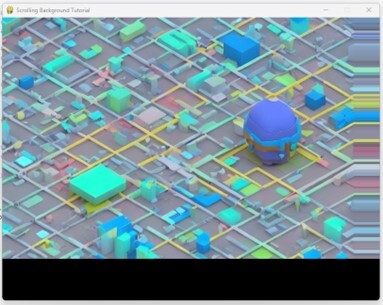Pygame 创建滚动背景
Pygame是一个用于构建游戏和多媒体应用程序的流行Python库。游戏开发中最重要的方面之一是创建滚动背景的能力。在本文中,我们将介绍创建Pygame中滚动背景的基本步骤。我们还将提供真实世界的示例和代码片段,以帮助您更好地理解这些概念。
其他可以用于Python游戏开发的库还包括:
- Arcade - Arcade是一个现代、易于使用的库,用于创建2D街机风格的游戏。它被设计成易于学习和使用,并提供了一系列功能,包括图形、声音和输入处理。
-
PyOpenGL - PyOpenGL是OpenGL 3D图形库的Python封装器。它提供了用于创建3D游戏的一系列功能,包括图形、光照和纹理映射。
-
Panda3D - Panda3D是一个游戏引擎和图形框架,提供了一系列用于创建3D游戏的功能。它被设计成易于使用,并支持多个平台,包括Windows、Mac和Linux。
-
Pyglet - Pyglet是一个跨平台的游戏库,提供了一系列用于创建2D和3D游戏的功能。它被设计成快速高效,并提供了一系列用于处理图形、声音和输入的工具。
这些库的优势因您的特定需求而异。使用这些库的一些优点可以包括:
- 易于使用 - 许多这些库都被设计成易于使用和学习,使其成为初学者或新手游戏开发人员的良好选择。
-
灵活性 - 这些库提供了一系列用于创建游戏的功能和工具,可以更容易地创建适合您特定需求的游戏。
-
性能 - 其中一些库被设计成快速高效,可以提高游戏的性能。
-
跨平台支持 - 许多这些库支持多个平台和操作系统,可以帮助您的游戏更广泛地面向大众。
先决条件
在我们深入了解如何在Pygame中创建滚动背景的细节之前,让我们回顾一些先决条件。
- pip install pygame
-
预计用户将能够访问任何独立的IDE,如VS-Code、PyCharm、Atom或Sublime Text。
-
甚至还可以使用在线Python编译器,如Kaggle.com、Google Cloud平台或其他平台。
-
Python更新版本。在撰写本文时,我使用的是3.10.9版本。
-
熟悉使用Jupyter notebook。
-
熟悉Pygame库。
-
基本了解2D图形和游戏开发概念。
如果您对任何先决条件不熟悉,我们建议在继续之前花一些时间熟悉它们。
创建滚动背景的步骤
创建滚动背景涉及几个步骤。我们将详细介绍每个步骤,并提供一些实际例子,帮助您入门。
步骤1:设置游戏窗口
创建滚动背景的第一步是设置游戏窗口。这可以使用pygame.display.set_mode()函数来完成。以下是一个示例:
import pygame
pygame.init()
设置游戏窗口
screen_width = 800
screen_height = 600
screen = pygame.display.set_mode((screen_width, screen_height))
pygame.display.set_caption("Scrolling Background Tutorial")
在这个例子中,我们导入Pygame库并初始化它。然后我们将游戏窗口的宽度和高度分别设置为800像素和600像素。最后,我们将screen变量设置为刚刚创建的带有标题为”Scrolling Background Tutorial”的游戏窗口。
步骤2:加载背景图像
下一步是加载将要滚动的背景图像。可以使用pygame.image.load()函数来完成。以下是一个示例 –
#Load background image
background_img = pygame.image.load("background.jpg")
在这个示例中,我们加载名为”background.jpg”的图像并将其存储在background_img变量中。
步骤3:滚动背景
下一步是滚动背景图像。这可以通过在游戏窗口上更改背景图像的位置来完成。以下是一个示例:
# Scroll the background
scroll_x = 0
scroll_y = 0
background_x = 0
while True:
for event in pygame.event.get():
if event.type == pygame.QUIT:
pygame.quit()
# Scroll the background horizontally
scroll_x -= 1
background_x -= 1
#Draw the background twice to create seamless scrolling effect
screen.blit(background_img, (scroll_x, scroll_y))
screen.blit(background_img, (background_x, scroll_y))
#Reset the background position when it goes off screen
if scroll_x <= -screen_width:
scroll_x = screen_width
if background_x <= -screen_width:
background_x = screen_width
pygame.display.update()
在这个例子中,我们将背景图像的初始位置设置为(0,0)。然后,我们创建一个while循环,该循环将持续运行直到游戏关闭。在while循环内部,我们通过-1逐渐增加scroll_x和background_x变量,将背景图像向左移动。然后我们使用screen.blit()函数两次绘制背景图像。这样创建了一个平滑滚动的效果。
步骤4:添加游戏对象
最后一步是将游戏对象添加到窗口中。可以使用Pygame库的各种绘图函数来完成。这是一个例子:
#Add game objects
player_img = pygame.image.load("player.png")
player_x = 400
player_y = 300
while True:
for event in pygame.event.get():
if event.type == pygame.QUIT:
pygame.quit()
#Scroll the background horizontally
scroll_x -= 1
background_x -= 1
#Draw the background twice to create seamless scrolling effect
screen.blit(background_img, (scroll_x, scroll_y))
screen.blit(background_img, (background_x, scroll_y))
#Reset the background position when it goes off screen
if scroll_x <= -screen_width:
scroll_x = screen_width
if background_x <= -screen_width:
background_x = screen_width
#Add game objects
screen.blit(player_img, (player_x, player_y))
pygame.display.update()
在这个例子中,我们使用screen.blit()函数将一个玩家对象添加到屏幕上。我们还将玩家对象的初始位置设置为(400,300)。
最终代码
# libraries
import pygame
pygame.init()
#Setting up the window
screen_width = 800
screen_height = 600
screen = pygame.display.set_mode((screen_width, screen_height))
pygame.display.set_caption("Scrolling Background Tutorial")
#Load background image
background_img = pygame.image.load("background.jpg")
# Scroll the background
scroll_x = 0
scroll_y = 0
background_x = 0
while True:
for event in pygame.event.get():
if event.type == pygame.QUIT:
pygame.quit()
# Scroll the background horizontally
scroll_x -= 1
background_x -= 1
#Draw the background twice to create seamless scrolling effect
screen.blit(background_img, (scroll_x, scroll_y))
screen.blit(background_img, (background_x, scroll_y))
#Reset the background position when it goes off screen
if scroll_x <= -screen_width:
scroll_x = screen_width
if background_x <= -screen_width:
background_x = screen_width
pygame.display.update()
#Add game objects
player_img = pygame.image.load("player.png")
player_x = 400
player_y = 300
while True:
for event in pygame.event.get():
if event.type == pygame.QUIT:
pygame.quit()
#Scroll the background horizontally
scroll_x -= 1
background_x -= 1
#Draw the background twice to create seamless scrolling effect
screen.blit(background_img, (scroll_x, scroll_y))
screen.blit(background_img, (background_x, scroll_y))
#Reset the background position when it goes off screen
if scroll_x <= -screen_width:
scroll_x = screen_width
if background_x <= -screen_width:
background_x = screen_width
#Add game objects
screen.blit(player_img, (player_x, player_y))
pygame.display.update()
结果


从上面的部分可以看到,有两个输出显示了背景图像的过渡或滚动,因此程序以正确和预期的输出工作。
结论
在本教程中,我们介绍了在Pygame中创建滚动背景的基本步骤。我们还提供了真实世界的例子和代码片段,以帮助您更好地理解这些概念。有了这些知识,您应该能够创建具有滚动背景的引人入胜的游戏。祝您编程愉快!
 极客笔记
极客笔记